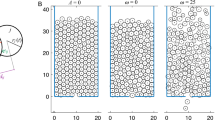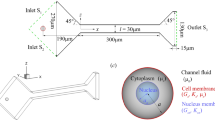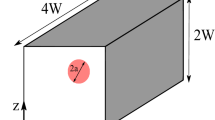Abstract
To understand the physical properties of lymphocytes and to develop a numerical model that can predict their motion and deformation in flows, a three-dimensional numerical simulation of lymphocytes flowing through the contraction region of a microchannel was performed using a compound drop model. The present model considers shear-thinning effects on the cytoplasm and the nucleus by modeling a second droplet inside the primary cell. The time-dependent characteristics of the deformation index (DI) of the lymphocyte, and the effects of the flow rate and the nucleus position on the DI are discussed and compared with the measurement. The results demonstrated that the conventional drop model, in which Newtonian fluid properties are applied to the cytoplasm, cannot correctly predict the deformation of the cell in the contraction region, where the nonlinear effects become important, whereas the compound drop model was consistent with experimental measurements of lymphocyte deformation. The size and position of the nucleus were found to influence the shape of the lymphocyte as measured by a change in the deformation rate of the leading and trailing sides of the lymphocyte. Further, a simplified model of lymphocyte deformation in the steady elongational flow was employed to determine the apparent viscosity, including the shear-thinning effects, of the lymphocyte.
Similar content being viewed by others
References
Gregg, E.C., Steidley, K.D.: Electrical counting and sizing of mammalian cells in suspension. Biophys. J. 5, 393–405 (1965)
Morgan, H., Sun, T., Holmes, D., Gawad, S., Green, N.G.: Single cell dielectric spectroscopy. J. Phys. D. Appl. Phys. 40, 61–70 (2007)
Schade-Kampmamm, G., Huwiler, A., Hebeisen, M., Hessler, T., Berardino, M.D.: On-chip non-invasive and label-free cell discrimination by impedance spectroscopy. Cell Prolif. 41, 830–840 (2008)
Perktold, K., Rappitsch, G.: Computer simulation of local blood flow and vessel mechanics in a compliant carotid artery bifurcation model. J. Biomech. 28, 845–856 (1995)
Taylor, C.A., Hughes, T.J.R., Zarins, C.K.: Finite element modeling of blood flow in arteries. Comput. Methods Appl. Mech. Eng. 158, 155–196 (1998)
Baumler, H., Neu, B., Donath, E., Kiesewetter, H.: Basicphenomena of red blood cell rouleaux formation. Biorheology 36, 439–442 (1999)
Chen, J., Lu, X.-Y.: Numerical investigation of the non-newtonian pulsatile blood flow in a bifurcation model with a non-planar branch. J. Biomech. 39, 818–832 (2006)
Bagchi, P.: Mesoscale simulation of blood flow in small vessels. Biophys. J. 92, 1858–1877 (2007)
Wang, T., Pan, T.-W., Xing, Z.W., Glowinski, R.: Numerical simulation of rheology of red blood cell rouleaux in microchannels. Phys. Rev. E 79, 041916 (2009)
Grinberg, L., Cheever, E., Anor, T., Madsen, J.R., Karniadakis, G.E.: Modeling blood flow circulation in intracranial arterial networks: A comparative 3D/1D simulation study. Ann. Biomed. Eng. 29, 297–309 (2011)
Mahalingam, M., Pozniak, A., Mcmanus, T.J., Vergani, D., Peakman, M.: Cell cycling HIV infection: analysis of in vivo activated lymphocytes. Experimental Immunology 102, 481–486 (1995)
Wurtzer, S., Compain, S., Benech, H., Hance, A.J., Clavel, F.: Effect of cell cycle arrest on the activity of nucleoside analogues against human immunodeficiency virus type 1. J. Virol. 79, 14815–14821 (2005)
Roda, B., Reschinglian, P., Zattoni, A., Luigi, P., Buzzi, M., Ricci, F., Bontadini, A.: Human lymphocyte sorting by gravitational field-flow fractionation. Anal. Bioanal. Chem. 392, 137–145 (2008)
Schmid-Schönbein, G.W., Sung, K.P., Tözeren, H., Skalak, R., Chien, S.: Passive mechanical properties of human leukocytes. Biophys. J. 36, 243–256 (1981)
Tsai, M.A., Frank, R.S., Waugh, R.E.: Passive mechanical behavior of human neutrophils: power-law fluid. Biophys. J. 65, 2078–2088 (1993)
Kan, H.C., Udaykumar, H.S., Shyy, W., Tran-Son-Tay, R.: Hydrodynamics of a compound drop with application to leukocyte modeling. Phys. Fluids 10, 760–774 (1998)
Evans, E., Needham, D.: Physical properties of surfactant bilayer membranes: thermal transitions, elasticity, rigidity, cohesion, and colloidal interactions. J. Phys. Chem. 91, 4219–4228 (1987)
Vigneron, P.: A Thesis Presented to the Graduate School of The University Of Florida, University of Florida (1998)
Dong, C., Skalak, R.: Leukocyte deformability: finite element modeling of large viscoelastic deformation. J. Theor. Biol. 158, 173–193 (1992)
Schmid-Schönbein, G.W., Shih, Y.Y., Chien, S.: Morphometry of human leukocytes. Blood 56, 866–875 (1980)
Luo, Z.Y., Xu, F., Lu, T.J., Bai, B.F.: Direct numerical simulation of single leukocyte deformation in microchannel flow for disease diagnosis. J. Med. Syst. 35, 869–876 (2011)
Kan, H.-C., Shyy, W., Udaykumar, H.S., Vigneron, P., Tran-Son-Tay, R.: Effects of nucleus on leukocyte recovery. Ann. Biomed. Eng. 27, 648–655 (1999)
Khismatullin, D.B., Truskey, G.A.: Three-dimensional numerical simulation of receptor-mediated adhesion to surfaces: effects of cell deformability and viscoelasticity. Phys. Fluids 17, 031505 (2005)
Drury, J.L., Dembo, M.: Aspiration of human neutrophils: effects of shear thinning and cortical dissipation. Biophys. J. 81, 3166–3177 (2001)
Peskin, C.S.: Numerical analysis of blood flow in the heart. J. Comput. Phys. 25, 220–252 (1977)
Yeung, A., Evans, E.: Cortical shell-liquid core model for passive flow of liquid-like spherical cells into micropipettes. Biophys. J. 56, 139–149 (1989)
Needham, D., Hochmuth, R.M.: A sensitive measure of surface stress in the resting neutrophil. Biophys. J. 61, 1664–1670 (1992)
Kaleridis, V., Athanassiou, G., Deligianni, D., Missirlis, Y.: Slow flow of passive neutrophils and sequestered nucleus into micropipette. Clin. Hemorheol. Microcirc. 45, 53–65 (2010)
Measurement Uncertainty, A S M E: Performance Test Codes ANSI/ASME PTC 19.1-1985. ASME, New York (1986)
Author information
Authors and Affiliations
Corresponding author
Rights and permissions
About this article
Cite this article
Tatsumi, K., Haizumi, K., Sugimoto, K. et al. Measurement and Analysis of Lymphocyte Deformation in Microchannel Contraction Flows Using a Compound Drop Model. Flow Turbulence Combust 96, 245–260 (2016). https://doi.org/10.1007/s10494-015-9633-1
Received:
Accepted:
Published:
Issue Date:
DOI: https://doi.org/10.1007/s10494-015-9633-1




